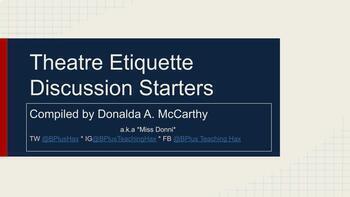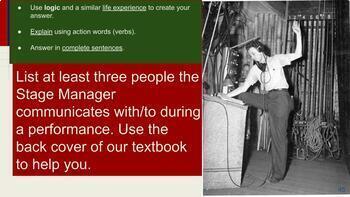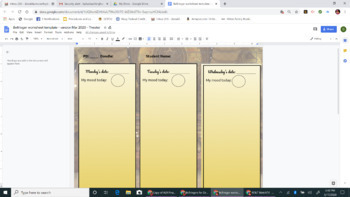Theatre Etiquette Discussion Prompts - a Full Semester of Bellringers!
- Google Slides™

What educators are saying
Description
BEST FOR SECONDARY STUDENTS.
WORKSHOPPED WITH MY HIGH SCHOOLERS (in America and Hong Kong)
This vivid PowerPoint offers both a Discussion Starter AND a Writing Prompt for each day in the First Semester. This can operate as a introduction to your expectations once in the theater space to your Drama I students. Alas, I've also found that taking all 90 slides as a REVIEW for my Advanced Drama students for the entire first week of school is a won.der.ful refresher of safety, expectations, and etiquette.
I include an optional two-sided worksheet with five spaces to write a response or Remember This notes. (Only my Beginning classes have ever actually used this.) The sixth space is labeled "Progress Log". Use this however you choose! My Advanced students and Stagecraft students are required, for example, to update me on their individual scene study or project each week. My Intro to Theater students have had to use new Theater Terms in sentences. Meanwhile, I've also used this space for a weekly quiz ON the new etiquette they've learned.
The slides include images and gifs so it is storage dense. Keep this in mind when deciding to download it or just use the Google Drive version.
The discussion starters are grouped how a Beginning class progresses before they're "let loose" in the theater space. And, knowing that many of our classes are just 'dumping grounds' for kids who haven't selected their own Elective yet, there's no out-of-seat work until the 15th day of school. (Obviously, you can modify this.)
- What IS "theater"?
- Safety protocol for dress
- Audience etiquette
- Who's Who backstage and 'up there'
- Areas of the stage and theater space
- The basics of how to NOT stand in a line onstage
- Respect the Crew and Techs
- Honor Thy Stage Manager
- Pencil versus Pens versus Highlighters on a script
- Bring your script. Bring it in a binder!
- Whyyy you must always always always bring your script to rehearsals
- Props Table 101
- Don't touch that!... or that!... ever!
- Who should clean that paintbrush.
- Where does that costume actually belong?
You're building up their "common sense" so, while their are really no wrong answers, you can guide each class or Theatre Programme to your own expectations via the discussion starters.
www.MissDonni.com
@BPlusTeachingHax





